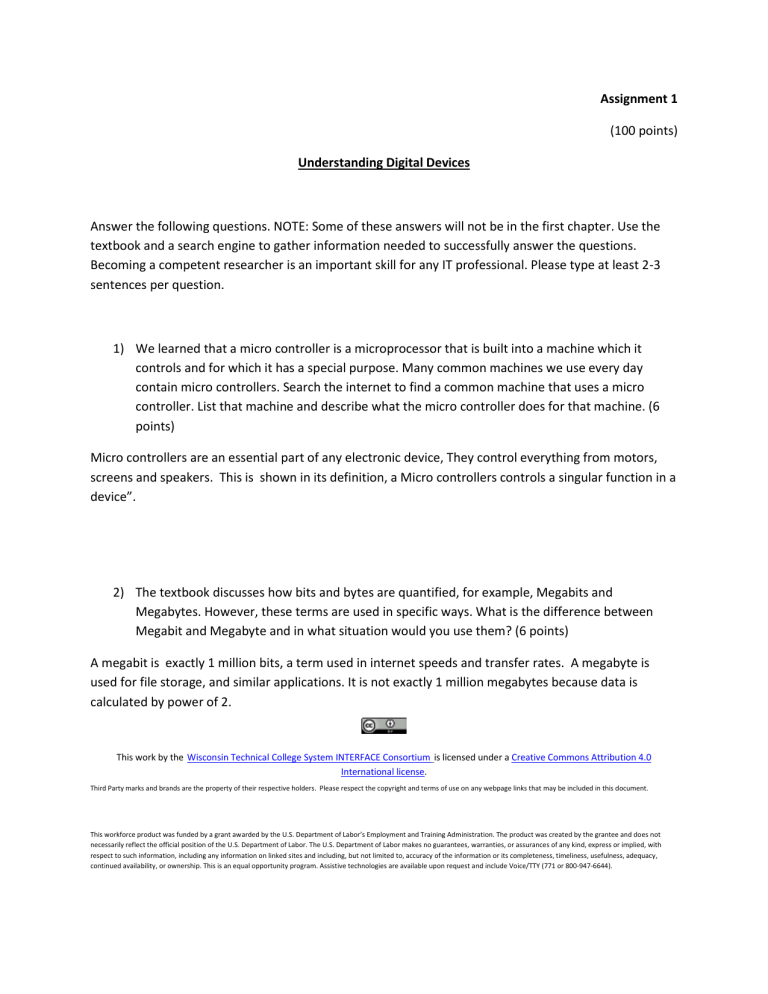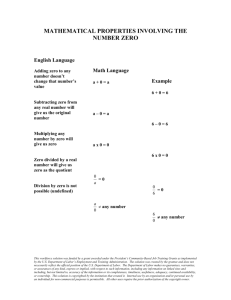Uploaded by
llowens391
Digital Devices Assignment: Microcontrollers, Bits, Code, Security
advertisement

Assignment 1 (100 points) Understanding Digital Devices Answer the following questions. NOTE: Some of these answers will not be in the first chapter. Use the textbook and a search engine to gather information needed to successfully answer the questions. Becoming a competent researcher is an important skill for any IT professional. Please type at least 2-3 sentences per question. 1) We learned that a micro controller is a microprocessor that is built into a machine which it controls and for which it has a special purpose. Many common machines we use every day contain micro controllers. Search the internet to find a common machine that uses a micro controller. List that machine and describe what the micro controller does for that machine. (6 points) Micro controllers are an essential part of any electronic device, They control everything from motors, screens and speakers. This is shown in its definition, a Micro controllers controls a singular function in a device”. 2) The textbook discusses how bits and bytes are quantified, for example, Megabits and Megabytes. However, these terms are used in specific ways. What is the difference between Megabit and Megabyte and in what situation would you use them? (6 points) A megabit is exactly 1 million bits, a term used in internet speeds and transfer rates. A megabyte is used for file storage, and similar applications. It is not exactly 1 million megabytes because data is calculated by power of 2. This work by the Wisconsin Technical College System INTERFACE Consortium is licensed under a Creative Commons Attribution 4.0 International license. Third Party marks and brands are the property of their respective holders. Please respect the copyright and terms of use on any webpage links that may be included in this document. This workforce product was funded by a grant awarded by the U.S. Department of Labor’s Employment and Training Administration. The product was created by the grantee and does not necessarily reflect the official position of the U.S. Department of Labor. The U.S. Department of Labor makes no guarantees, warranties, or assurances of any kind, express or implied, with respect to such information, including any information on linked sites and including, but not limited to, accuracy of the information or its completeness, timeliness, usefulness, adequacy, continued availability, or ownership. This is an equal opportunity program. Assistive technologies are available upon request and include Voice/TTY (771 or 800-947-6644). 3) Describe the difference between source code and object code. (6 points) Source code is Human readable code in a common programming language. Meanwhile Object Code is what is compiled from Source code that a machine reads and executes on its components. 4) If you forget your password to log into an online account, the website generally offers a ‘forgot my password’ feature that will make you answer a series of security questions you set up when you created the account. Some of the most common security questions include, “What is your mother’s maiden name?”, “What was your high school mascot?”, and “In what city were you born?”. Why would you not want to use these particular security questions? (7 points) These are all PII (personal identifying information which could be found via OSINT, (Open source Intelligence) With the correct skills making your account Security weaker because a hacker could gain access to that information. This work by the Wisconsin Technical College System INTERFACE Consortium is licensed under a Creative Commons Attribution 4.0 International license. Third Party marks and brands are the property of their respective holders. Please respect the copyright and terms of use on any webpage links that may be included in this document. This workforce product was funded by a grant awarded by the U.S. Department of Labor’s Employment and Training Administration. The product was created by the grantee and does not necessarily reflect the official position of the U.S. Department of Labor. The U.S. Department of Labor makes no guarantees, warranties, or assurances of any kind, express or implied, with respect to such information, including any information on linked sites and including, but not limited to, accuracy of the information or its completeness, timeliness, usefulness, adequacy, continued availability, or ownership. This is an equal opportunity program. Assistive technologies are available upon request and include Voice/TTY (771 or 800-947-6644). Rubric Level of Achievement General Approach Comprehension Exemplary Follows instructions and addresses the question. States a relevant and justifiable answer. Presents arguments in a logical order. Uses acceptable style and grammar with no errors. Includes images for reference. Demonstrates a complete understanding of the question. Backs answers with data and justifications. Uses 2 or more ideas, examples or arguments to support the answer. Does not accurately follow instructions or does not address the question directly, but does so tangentially. States a relevant answer. Uses acceptable style and grammar (1-2 errors). Demonstrates an accurate, but only adequate level of understanding of the question. Uses only 1 idea to support the answer. Does not follow instructions, or does not really address the question. States few relevant answers. Reveals some misconceptions. Is not clearly or logically organized. Errors in style and grammar (3-4 errors). Does not demonstrate an accurate understanding of the question, but makes an effort. No evidence to support the answer. 6-7 points Meets expectations 4-5 points Approaching expectations 2-3 points This work by the Wisconsin Technical College System INTERFACE Consortium is licensed under a Creative Commons Attribution 4.0 International license. Third Party marks and brands are the property of their respective holders. Please respect the copyright and terms of use on any webpage links that may be included in this document. This workforce product was funded by a grant awarded by the U.S. Department of Labor’s Employment and Training Administration. The product was created by the grantee and does not necessarily reflect the official position of the U.S. Department of Labor. The U.S. Department of Labor makes no guarantees, warranties, or assurances of any kind, express or implied, with respect to such information, including any information on linked sites and including, but not limited to, accuracy of the information or its completeness, timeliness, usefulness, adequacy, continued availability, or ownership. This is an equal opportunity program. Assistive technologies are available upon request and include Voice/TTY (771 or 800-947-6644). Does not meet expectations 0-1 points Does not complete instructions or does not address the question at all. States no answer or only partial answer. No style or organization. Many errors in grammar (5 or more). Question was not answered or no evidence of understanding of the question exists. Style and grammar interfere with the readability of the answer. This work by the Wisconsin Technical College System INTERFACE Consortium is licensed under a Creative Commons Attribution 4.0 International license. Third Party marks and brands are the property of their respective holders. Please respect the copyright and terms of use on any webpage links that may be included in this document. This workforce product was funded by a grant awarded by the U.S. Department of Labor’s Employment and Training Administration. The product was created by the grantee and does not necessarily reflect the official position of the U.S. Department of Labor. The U.S. Department of Labor makes no guarantees, warranties, or assurances of any kind, express or implied, with respect to such information, including any information on linked sites and including, but not limited to, accuracy of the information or its completeness, timeliness, usefulness, adequacy, continued availability, or ownership. This is an equal opportunity program. Assistive technologies are available upon request and include Voice/TTY (771 or 800-947-6644).


